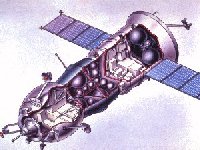
Salyut 4 space station with a Soyuz-T capsule docked to it. The Soyuz-T is a refit of the original model.
Image found on the internet, presumably scanned from the Encyclopedia of Spce Technology

On June 16, 1971, Soyuz 11 launched from Russia, carrying 3 cosmonauts up to the Salyut I space station, making it the first permenantly manned Terran space station. Cosmonauts Dobrovolsky, Volkov, and Paskaiev stayed on board their new home in space for over 23 days. Unfortunately, their departure marked one of the first major tragedies to occur in space to date. While undocking, a pressure valve failed to close, causing the Soyuz capsule to depressurize, killing all three astronauts. Not since January of 1967 when the crew of Apollo I perished in a fire in their capsule had such a tragedy taken place in the Terran space program.
Despite this setback, the Russian space administration was undaunted. They continued forth with the Salyut project after modifying the life support equipment to make sure that an accident like this would not happen again. The project resulted in a total of 7 separate space stations being launched in this series. Salyut 2 was the only station that was not manned. It was launched to test new systems for future space stations.
The most succesful Salyut stations were the 6th and 7th to be launched. The 6th was the first to begin a series of experiments by Russia in space technology. Some of the experiments conducted on these flights include zero-g metals soldering, crystal growth, metallurgical studies, optical technology, and biotechnology. Salyut 6 also marked an advance in station technology in that ti was the first to feature more than one docking port. Up until now, the stations only had one docking port, allowing only one Soyuz to dock at a time. And, ever since the accident involving Soyuz 11, all subsequent capsules only carried 2 people. With the addition of the extra docking port on Salyut 6, that meant that more than two crewmen could be on board at one time. Salyut 6 also marked the first use of the Soyuz-Progress class of unmanned freighter capsules used to refuel and resupply the space station, allowing crews to stay up for longer missions.

Salyut 7 eventually set the standards for subsequent space mission lengths. The first crew stayed for 211 days, more than twice as long as any other mission thus far. Another mission lasted 236 days.
The Salyut series of space station was officially retired on February 20, 1986 when the Mir space station began its long and succesful run. Mir benifitted much from the experience gained in Salyut, and ended up surpassing all of the old records, allowing the Russians to be the leaders in space station and long endurance space missions into the early 21st century.
Specifications:
Length: 15 meters
Diameter: 4.1 meters
Useful Volume: 90 cubic meters
Mass: 19.6 tonnes
Propulsion: Chemical thrusters for reaction control and orbital correction